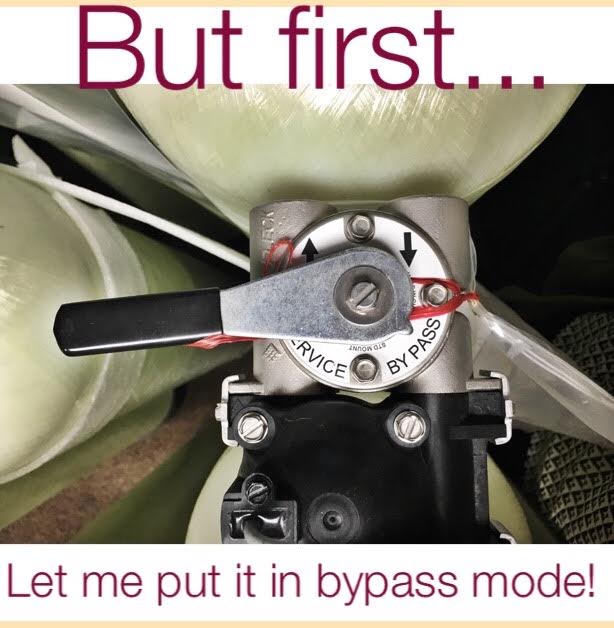
We talk smack about hard water almost all the time, we admit it.
But there is something worse than hard water… And that’s no water.
If there is one thing you need to be able to locate on your softener, it is the bypass function
Think of the bypass as an on-and-off switch.
When your softener is behaving like it should, it stays in service mode. But if it gets into an issue and starts acting out? Show that softener who’s the boss–switch it into bypass mode!
Bypass looks and is operated differently depending on the model, make, and year it was made; they can be push-style, lever-style, crank-style and turn-style.
I made this short video to show you a few examples…
Let’s say you’re heading to the basement when you are greeted by a beautiful standing pool of water near your softener. The water is definitely spraying out of a leak in your softener.
What should you do?
Put it in bypass!
While the softener is in bypass, your home will be receiving hard water.
Bypass stops your softener from doing its job–softening your water–but it does NOT shut off your home’s water supply.
Just for good measure, let me repeat that:
The bypass does not shut off your home’s water supply,
it only shuts off your water’s access to the softener.
So, at this point in our hypothetical situation, you’re cleaning up your flooded basement. You’ve temporarily bypassed the softener long enough for Peterson Salt to arrive and fix the problem. Now that you’ve been serviced, go look at your softener.
The technician should have switched your unit back into service mode.
If you don’t switch back to service mode, you’ll get hard water.
On occasion, homeowners call in reporting unusual, sudden changes in their water quality, and it’s because their water softener has been left in bypass mode for whatever reason.
Some scenarios that sound suspiciously like bypass issues…
“I haven’t had an issue with my water softener in the last 20 years, but ever since a re-modeling crew came in to help with my basement I’ve had hard water. What’s the deal? Did somebody mess with the softener settings?”
or…
“I just had a new washer/dryer installed, but now my clothes look and feel noticeably dingier after I do laundry. This softener is new–I’ve only had it a year–and it usually works great! Is it broken?”
The very first thing I advise these folks with uncommon quality hiccups?
Check that it’s not in bypass!
A simple, quick fix could save you a service call fee.
Each case is unique, and we strongly encourage folks to continue calling us with questions whenever things seem fishy. But no matter the issue, checking the bypass is your first step.
For a more thorough tutorial on the water softener bypass, here’s a video A.J. made in 2014:
So, on that note…
Happy Water Word Wednesday!!!
salt bridge:
- Salt bridge: a salty crust that can form in your brine tank, preventing the salt and water from dissolving into the brine solution. The salt bridge creates a gap of space between the salt and water, and if you have one, you’ll need to break it up.
How you can use it in a sentence today…
Tom:
“My tank looked full of salt today, but the water was hard.”
A.J.:
“Were you stuck in bypass mode?”
Tom:
“No, a salt bridge formed inside.”
A.J.:
“Did you break it with a broom handle?”
Tom:
“Sure did. Man, those salt bridges are sneaky!”
